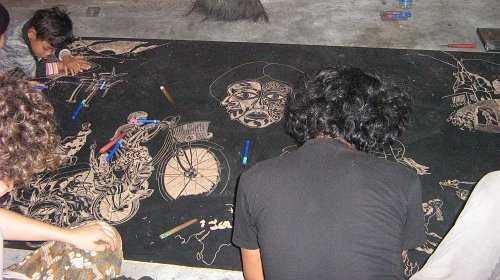

leave your comments
 printable page
printable page
I've had the opportunity to visit the family house and atelier of Taring Padi, an artist collective of international fame producing amazing paintings.

The technique they use is carving a large plate of wood, which is then used as a master in printing on large tissues. What is really fascinating for me is to see how the whole creation process is collective, as the size of the carved wood lets host the visions of many people at once, crawling on the large surface to merge their drawings with the others.

Their style is well aware of traditions, but at the same time updated to contemporary issues. Taring Padi is well engaged on social and political matters that are very important to Indonesia as well to the rest of our World.
They give voice to people's struggles against capitalist and imperialist oppression, denouncing massacres that happened in a recent Indonesian past. The scenes depicted detail well the collusion between foreign capitalist speculations and Indonesian war criminals, as well the corruption of leaders that feel no shame to sell Indonesian national heritage, along with people's lives and natural resources for money.
Their voice is choral, powerful and direct, while it doesn't neglects a pars costruens in their outcry for justice, as they remark the importance of simple peasant traditions for a sustainable and ecological living.
While being a guest at Taring Padi I could observe the making of a new collective painting that involved a dozen of people, so i took the initiative to document this process.
It can be said that Taring Padi is doing open source art, as this modest documentation effort was welcomed by artists to be published, in the hope it can inspire even more artist communities around the World.

The big paintings produced are printed in a technique similar to the one realized by this machine (i miss the english term for it) using a wood plank as a matrix and large textiles as the final support to be printed (or maybe could be said stamped).

First the wooden matrix is prepared by taking a large wooden plank (slightly larger than the final printing) and covering one surface with thick black paint.
As the black paint is dry, we have a "tabula rasa" that multiple people at once can carve in different parts, crawling on it. The drawing is developed by taking away the black surface with pointed metal carvers; it must be kept in mind that the final result will be horizontally mirrored, especially when including texts.


As I was also invited to contribute to this artwork, you can see the detail of the forkbomb carved on the polluting industry - it will hopefully crash all capitalist industries around the world within 333 days from its printing.
Of course the carving part is the most creative in the whole process. Once the wooden matrix is filled with the artwork subject, it is time to proceed with the printing on textile.
Ink will be rolled in a uniform way on the surface of the wooden plank.




Once all surface is well inked, it is time to roll the textile on the wooden plank: it has to be done carefully so that there are no wrinkles left. While proceeding unrolling the textile, the surface of the textile must be immediately covered with paper.




Once the rolling and covering is done, comes the funny part: the textile must be well pressed in every point to adhere to the matrix and absorb the ink, so that it will be printed in a uniform way. I call it funny part because i saw Taring Padi artists having lots of fun while doing it, using their feet and improvising some propitiatory dances and what not...




When you think you had enough then is the time to unveil the result, first by carefully removing the paper that was laid on the printed tissue:


and then by lifting the printed textile with an agile and natural move that waves it up from the matrix without rubbing it around

Et voila'! The opera is ready to be hanged and admired, while drying the last bits of fresh ink.
Many thanks to the many artists involved in Taring Padi for the good time and incredibly inspiring visions: keep resisting, we will live long & prosper!

|


|




|
 copyleft 2000 - 2009 dyne.org
foundation and respective authors. Verbatim copying
and distribution is permitted in any medium, provided
this notice is preserved.
Send inquiries & questions to dyne.org's hackers. copyleft 2000 - 2009 dyne.org
foundation and respective authors. Verbatim copying
and distribution is permitted in any medium, provided
this notice is preserved.
Send inquiries & questions to dyne.org's hackers.
|

|